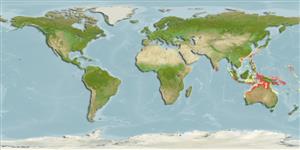Environment: milieu / climate zone / Tiefenbereich / distribution range
Ökologie
seewasser; brackwasser benthopelagisch; tiefenbereich 1 - 50 m (Ref. 9772). Tropical
Western Central Pacific: along coasts of northwestern Australia and southern Papua New Guinea.
Size / Gewicht / Alter
Geschlechtsreife: Lm ? range ? - ? cm
Max length : 13.5 cm SL Männchen/unbestimmt; (Ref. 9772)
Rückenflossenstacheln (insgesamt) : 10; Rückenflossenweichstrahlen (insgesamt) : 33 - 36; Afterflossenstacheln: 2; Afterflossenweichstrahlen: 7. Upper rostral pore median only; mental pores in 3 pairs, the first open at front of chin, separated by symphysis. Gill rakers long, slender, about 1.5 times longer than gill filaments at angle of arch, 13 to 17 on lower limb of first arch. Dorsal fin with IX spines, the second part of fin with I spine and 33 to 36 soft rays. Second spine of anal fin short, slender, 23 to 33 % of head length. Pectoral fin long, 25 to 27 % of standard length. Scales on head and body cycloid (smooth), except the belly and under side of caudal peduncle which are covered with weak ctenoid scales (slightly rough to touch); small scales present on basal quarter of soft parts of dorsal and anal fins. Swim bladder carrot-shaped; with about 26 pairs of arborescent appendages along its sides; each appendage with a well-developed dorsal and ventral limbs, the first pair entering head beyond transverse septum.
Body shape (shape guide): fusiform / normal.
Inhabits shallow coastal waters and estuaries to depths of 50 m (Ref. 9772).
Life cycle and mating behavior
Geschlechtsreife | Fortpflanzung | Ablaichen | Eier | Fecundity | Larven
Sasaki, K., 2001. Sciaenidae. Croakers (drums). p.3117-3174. In K.E. Carpenter and V.H. Niem (eds.) FAO species identification guide for fishery purposes. The living marine resources of the Western Central Pacific. Volume 5. Bony fishes part 3 (Menidae to Pomacentridae). Rome, FAO. pp. 2791-3380. (Ref. 9772)
IUCN Rote Liste Status (Ref. 130435: Version 2025-1)
Bedrohung für Menschen
Harmless
Nutzung durch Menschen
Fischereien: nicht kommerziell
Tools
Zusatzinformationen
Download XML
Internet Quellen
Estimates based on models
Preferred temperature (Ref.
123201): 24.6 - 28.8, mean 27.9 °C (based on 198 cells).
Phylogenetic diversity index (Ref.
82804): PD
50 = 0.6250 [Uniqueness, from 0.5 = low to 2.0 = high].
Bayesian length-weight: a=0.00851 (0.00415 - 0.01744), b=3.08 (2.91 - 3.25), in cm total length, based on LWR estimates for this (Sub)family-body shape (Ref.
93245).
Trophic level (Ref.
69278): 3.4 ±0.5 se; based on size and trophs of closest relatives
Widerstandsfähigkeit (Ref.
120179): hoch, Verdopplung der Population dauert weniger als 15 Monate. (Preliminary K or Fecundity.).
Fishing Vulnerability (Ref.
59153): Low vulnerability (10 of 100).
🛈
